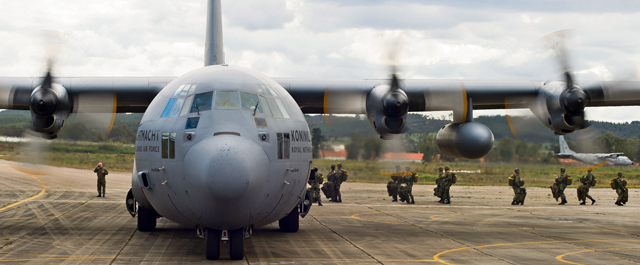
Six allied nations gathered to reflect on lessons and partnerships as exercise Real Thaw 16 came to a close March 4 in Beja, Portugal.
Real Thaw 16, a Portuguese-hosted NATO exercise, provided tactical training to participating nations. Its aim was to merge and employ different aerial platforms toward one major objective, which covered a vast range of activities to include defensive and offensive counterair operations, high-value air assets protection and slow-mover protection.
Airmen from Ramstein took advantage of the opportunity they were given and grew their skills with their wingmen and foreign counterparts.
“It was exciting to have Ramstein be a part of Real Thaw this year,” said Col. Gerald Donohue, 86th Operations Group commander. “The exercise was a great way for us to test our operations and pinpoint areas that could be improved upon. Though we could only be there for a week, the experience we gained will last a lifetime, and we look forward to working with our allies during future endeavors.”
Along with improving their capabilities of the C-130J Super Hercules, the Ramstein team also took time to build rapport with the other nations involved in the exercise.
“Our major focus was to build partner capacity and interoperability to operate with the Portuguese and other NATO countries during real-world missions,” said Capt. Jacob Fuchs, 37th Airlift Squadron deputy mission commander for Real Thaw 16. “The combined air operations portion where we were able to fly with other airframes allowed us to interface with units we normally wouldn’t see on any given day. This training is vital to us operating in a tactical environment and working alongside our foreign counterparts to make us that much better.”
The importance of Ramstein’s airlift capability was showcased during the exercise, airdropping approximately 116 personnel and 23 tons of cargo and flying 15 sorties within the week.
“Airlift is essential to the warfighters on the ground,” Donohue said. “We supply everything from equipment to personnel and all the resources in between. It is our job to ensure what is needed for the fight is delivered, and taking part in Real Thaw gave our pilots the scenarios needed to grow and perfect their skills to save the lives that depend on them.”
Though working with the C-130J is not new for the 37th AS Airmen, having the opportunity to see how other nations operate their aircraft presented possible solutions to improve upon their capabilities.
“Our counterparts operate by using completely different techniques, and seeing that taught us a lot,” Fuchs said. “From how the pilots fly their aircraft to how the paratroopers jump out of them, it is refreshing to see new ways to do a certain job, and we are going to look at how we could possibly incorporate some of them.”
It is their dedication to learn and have an open mind that makes the Ramstein team so great, Donohue stated.
“Our Airmen are the best out there,” Donohue said. “Not because they can manage any obstacle or accomplish missions without a hitch but because no matter how great they are, they always strive to be better. They thrive from growing their skills and teaching those around them, and when put in an environment where they can learn from other nations, they are like a sponge.”
Though the exercise concluded, the U.S. Airmen look forward to strengthening their ties with their NATO allies in both training and real-world future operations.







